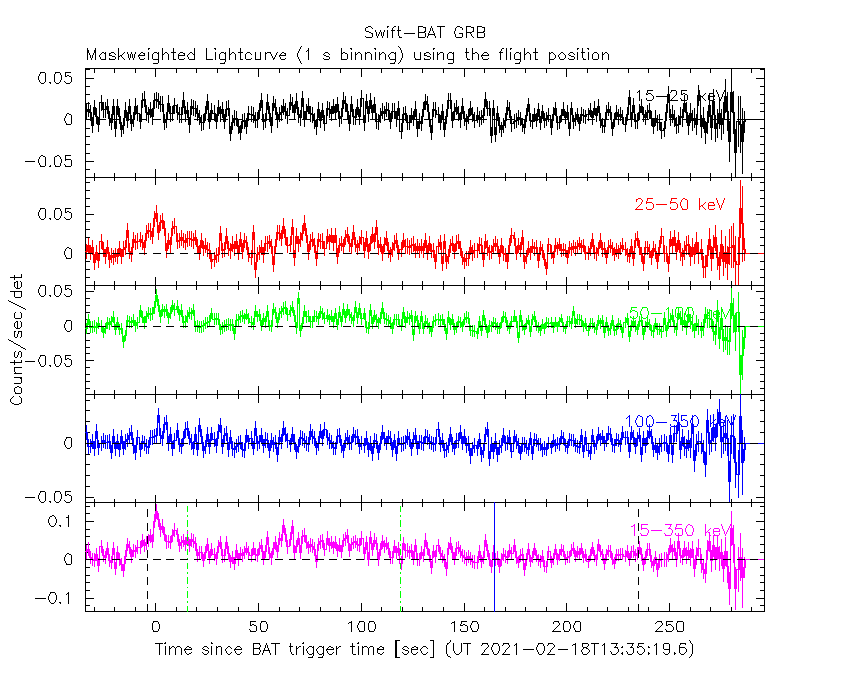
B. Sbarufatti (PSU), J.P. Osborne (U. Leicester) and A. Belles (PSU) for the Swift team
At 13:35:19 UT, the Swift Burst Alert Telescope (BAT) triggered and located GRB 210218A (trigger=1033328) (Sbarufatti et al. GCN Circ. 29529). Swift did not slew immediately due to an observing constraint. At the time of the trigger, the initial BAT position was 85° from the Sun (5.0 hours East) and 21° from the 39%-illuminated Moon. Table 1 contains the best reported positions from Swift.
Table 2 is a summary of GCN Circulars about this GRB from observatories other than Swift.
Standard analysis products for this burst are available at https://gcn.gsfc.nasa.gov/swift_gnd_ana.html.
As reported by Stamatikos et al. (GCN Circ. 29537),
the BAT ground-calculated position is RA, Dec = 47.318, 35.322 deg which is RA(J2000) = 0
The mask-weighted light curve (Figure 1) shows a multi-peaked structure that starts at ~T-15 s and peaks at ~
The time-averaged spectrum from T-14.27 to T+266.26 s is best fit by a power law with an exponential cutoff.
This fit gives a photon index 0.77 ± 0.49, and
The results of the batgrbproduct analysis are available at https://gcn.gsfc.nasa.gov/notices_s/1033328/BA/.
Analysis of the initial XRT data was reported by Sbarufatti et al. (GCN Circ. 29573).
The Swift/UVOT began settled observations
(Belles and Sbarufatti GCN Circ. 29556) of the field of GRB 210218A approximately 170 ks after the BAT trigger (B.
Sbarufatti et al., GCN Circ. 29529) due to a Moon constraint.
Table 3 gives preliminary
magnitudes using the UVOT photometric system
(Breeveld et al. 2011, AIP Conf. Proc., 1358, 373).
No correction has been made for the expected extinction in the Milky Way
corresponding to a reddening of

Figure 1. The BAT
mask-weighted light curve in the four individual and total
energy bands. The units are counts
| RA (J2000) | Dec (J2000) | Error | Note | Reference |
|---|---|---|---|---|
| 0 |
+35°19'26.5" | 4.8" | XRT-final | UKSSDC |
| 0 |
+35°19'26.5" | 4.80" | XRT | ? |
| 0 |
+35°19'18.9" | 1.4' | BAT-refined | Stamatikos et al. GCN Circ. 29537 |
| Band | Authors | GCN Circ. | Subject | Observatory | Notes |
|---|---|---|---|---|---|
| Optical | Zhu et al. | 29530 | NEXT optical upper limit | Xinjiang Astro. Obs. | upper limits |
| Optical | Xin et al. | 29531 | : GWAC-F60A optical upper limit | Xinglong Obs. | upper limits |
| Optical | Ogawa et al. | 29532 | MITSuME Akeno optical upper limits | MITSuME Akeno | upper limits |
| Filter | Exp(s) | Mag | ||
|---|---|---|---|---|
| wh | 170031 | 188263 | 1665 | >21.65 |
Table 3. UVOT observation reported by Belles and Sbarufatti (GCN Circ. 29556). The start and stop time of the exposure are given in seconds since the BAT trigger. The preliminary 3-σ upper limit is given. No correction has been made for extinction in the Milky Way.
February 27, 2021